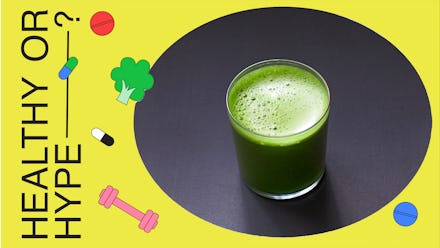Can this TikTok trend really banish acne and body odor?

If you’ve spent any time on wellness TikTok, you’ve probably noticed a number of videos of people swearing by a supplement known as liquid chlorophyll, claiming that it cleared up their skin and/or their stank. They typically squeeze a few drops of the verdant liquid into a glass of water, creating a mesmerizing marbling effect. But vintage apothecary vibes don’t necessarily equate to actual health benefits. Can drinking liquid chlorophyll really banish acne and B.O.?
As a journalist who reports on wellness and social justice, I scroll through TikTok for content on the latter, not so much the former. Much of the wellness advice I encounter seems pretty sus, and liquid chlorophyll is no exception. I asked Cindy Wassef, assistant professor at the center for dermatology at Rutgers Robert Wood Johnson Medical School, to weigh in on this trend.
What is chlorophyll, exactly?
Let’s start with a biology refresher: Chlorophyll is what makes plants green, Wassef explains, and it’s involved in photosynthesis, a process that helps plants harness sunlight to grow and absorb energy. But since chlorophyll isn’t water-soluble, most liquid chlorophyll supplements are technically sodium copper chlorophyllin, Wassef says, a water-soluble derivative of chlorophyll.
It turns out that chlorophyllin has some antiaging, antioxidant, and antibacterial properties, she adds, which could explain why TikTokers have jumped on liquid chlorophyll as an acne remedy. Indeed, skincare products marketed as anti-acne often contain chlorophyllin. Although a few studies support using it to treat acne, Wassef pointed out that they used a topical version, not an oral one. They were also really small, making it hard to generalize their findings and rule out chance as a factor. So far, there doesn't seem to be data on whether oral chlorophyllin can treat acne.
Is liquid chlorophyll good for you?
Why can't we automatically conclude that oral chlorophyllin has the same effects as topical chlorophyllin? Simply put, when you swallow something, you don’t have much say over where it produces its supposed benefits. “When you take something orally, it can help your body as a whole," Wassef says. “But you can’t necessarily control... whether it’s going to end up where you want it to be in your skin.”
Vitamin C is another example, she adds. Taking a vitamin C supplement is great for your overall health, but it’s when you apply it directly to your skin that you see it help with brown spots and aging. Likewise, the studies of topical chlorophyllin as an acne treatment involved applying it directly to where the participants wanted to see results, Wassef tells me.
Chlorophyll’s antibacterial properties might’ve convinced some people that liquid chlorophyll can neutralize their stank. But science doesn’t seem to back up this claim, either. “There’s very little, if any, data that supports [the use of] oral chlorophyll when it comes to improving the smell of sweat or decreasing sweat,” Wassef says. She notes that studies of topical chlorophyllin as a deodorant are even more scant than those looking at it as an acne treatment — researchers conducted them decades ago, but didn’t see as much improvement as they would’ve liked.
Chlorophyll’s antibacterial properties might’ve convinced some people that liquid chlorophyll can neutralize their stank.
Basically, the claims that liquid chlorophyll can smooth out your complexion and make you smell fresh as a daisy are pretty dubious. But say you want to try it anyway — how safe is it?
As with any supplement, Wassef recommends proceeding with caution. Since supplements aren’t FDA-regulated, companies don’t need to prove they’re safe or effective in order to sell them. They may even contain additives, Wassef points out. She believes the safest way to incorporate chlorophyll into your diet is to eat kale, spinach, and other leafy greens — even if it may not look as cool as drinking a green potion.